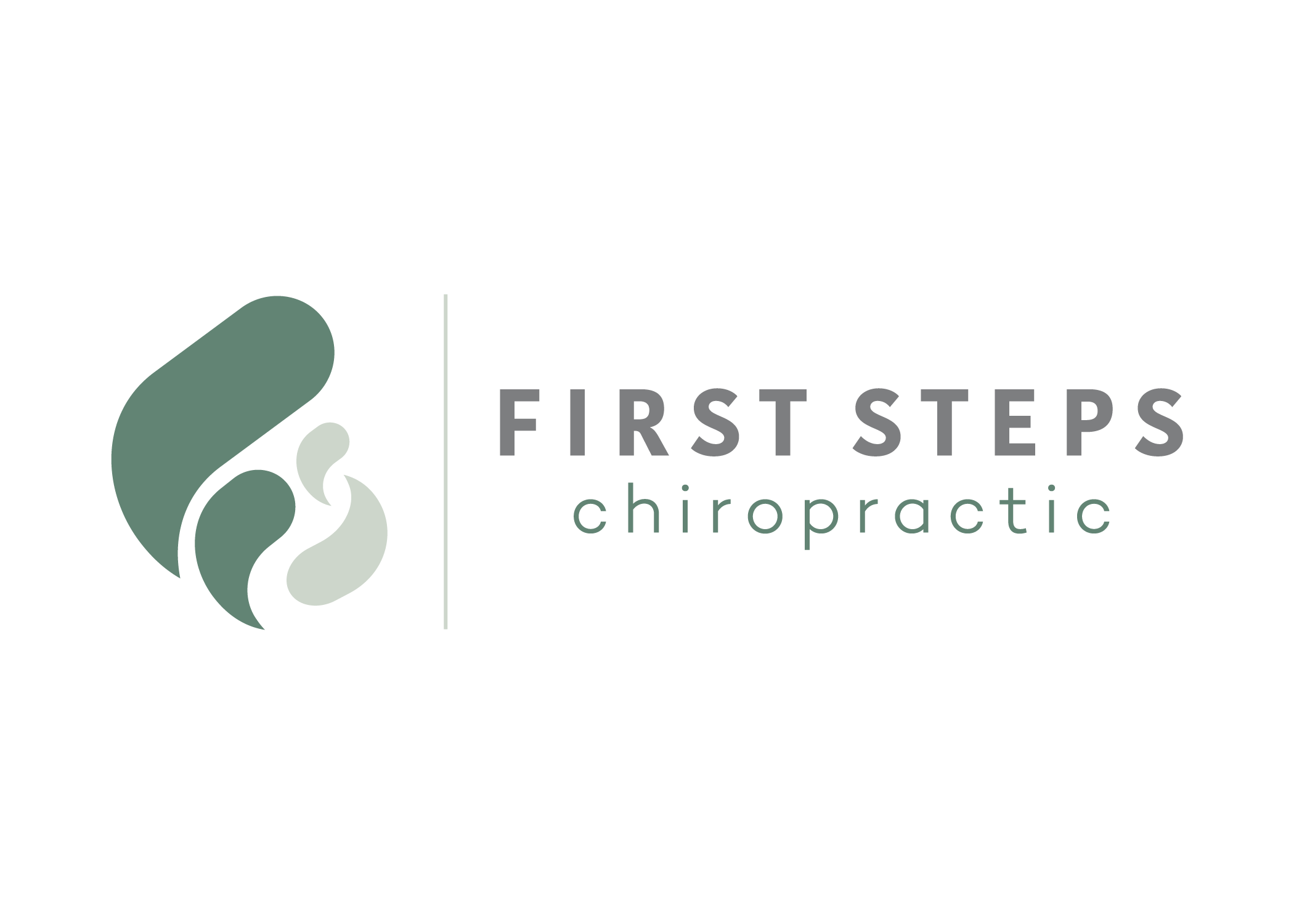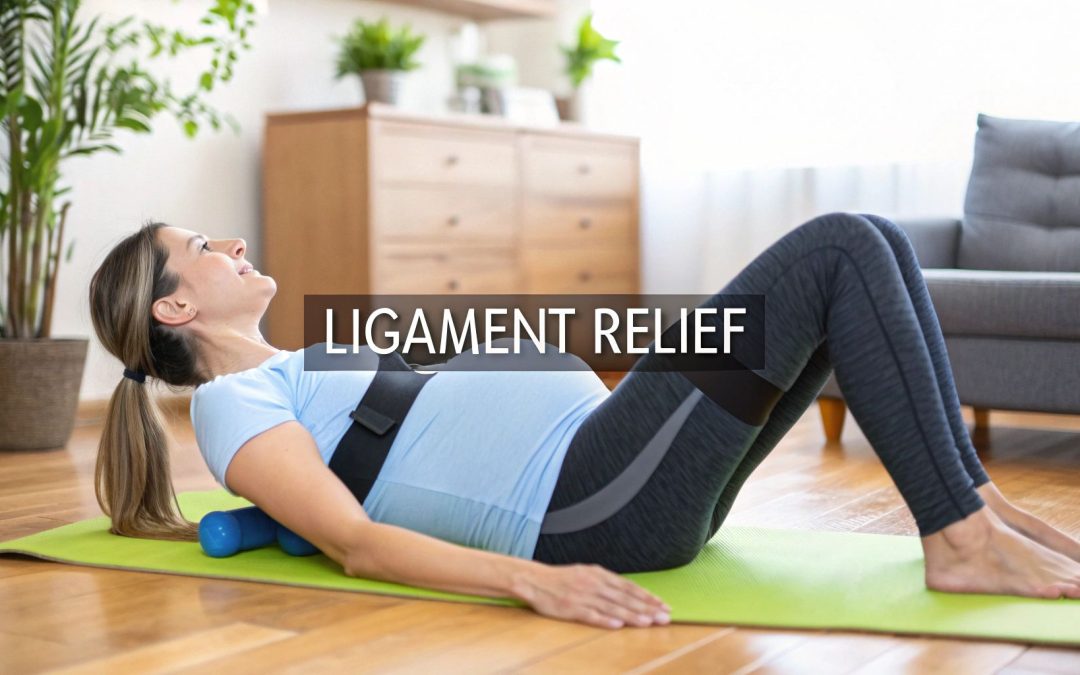If you’ve ever been jolted by a sudden, sharp pain in your lower belly when you move, you might be dealing with round ligament pain. It’s a completely normal, albeit uncomfortable, part of pregnancy. For some quick relief, try to change positions slowly, gently flex your hips before you sneeze or cough, or apply some mild, safe warmth to the area.
Understanding Round Ligament Pain in Pregnancy
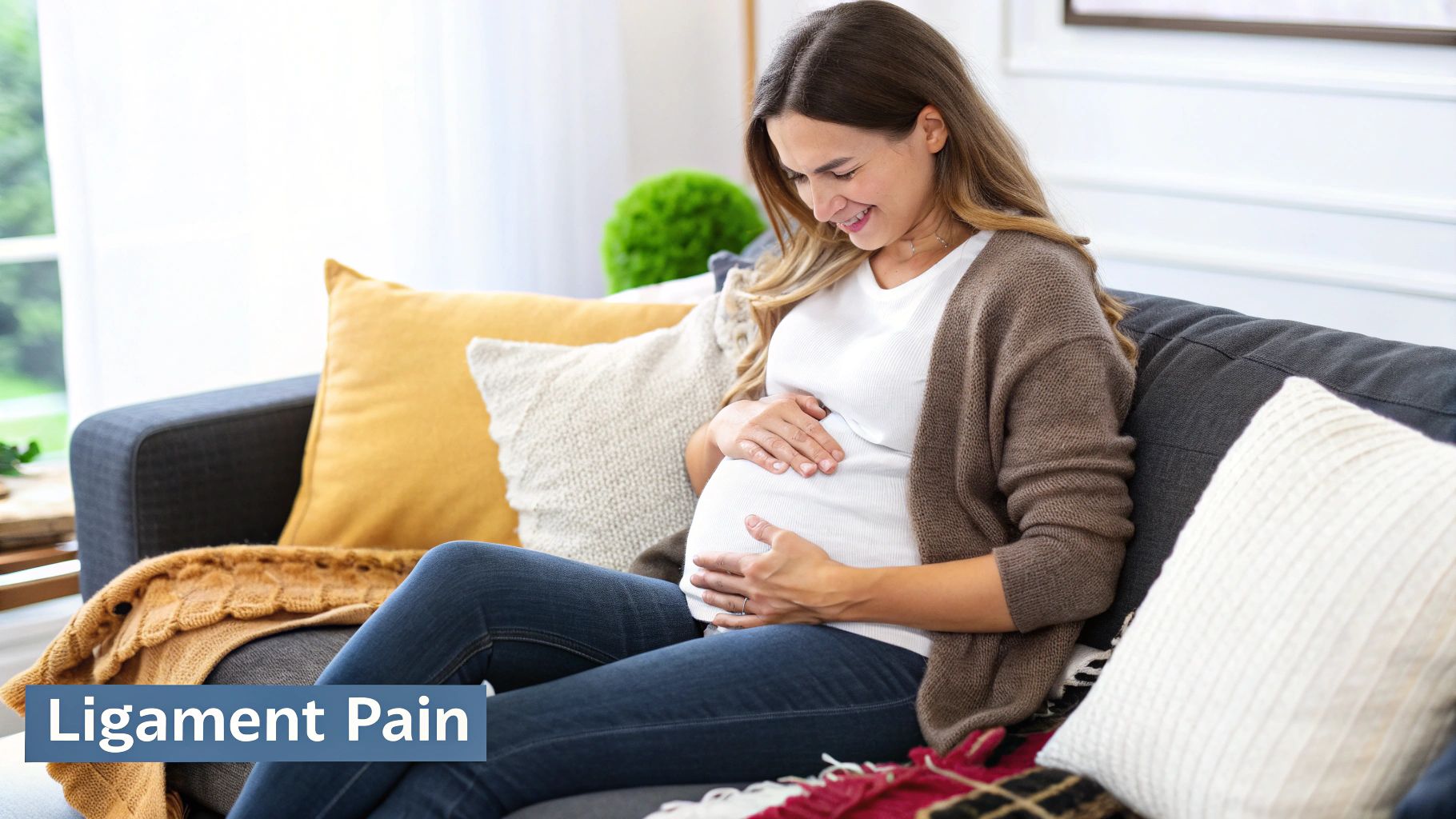
That sharp, jabbing sensation deep in your groin or lower abdomen is one of pregnancy’s most common—and surprising—discomforts. Think of your round ligaments as two rope-like structures that act like guy-wires, supporting your growing uterus by connecting it to your pelvis. As your baby grows, these ligaments have to stretch, thin out, and work much harder than they're used to.
Sometimes, a quick movement like standing up too fast, rolling over in bed, or even just a sudden cough can cause these ligaments to tighten abruptly. The result is a brief but intense spasm. This is the hallmark of round ligament pain, and if you've felt it, you know exactly what I'm talking about.
Why Does This Happen?
The main reason for this pain is the simple mechanical stress of pregnancy. Your body is going through incredible changes, and the round ligaments are just trying to keep up with the increased demand. While it can be startling, this pain is usually a normal sign that your body is adapting.
It’s a very common experience, affecting between 10% and 30% of pregnancies. So if you're feeling this, you're definitely not alone.
Most women describe the feeling as:
- A sharp, stabbing sensation on one or both sides of the lower belly.
- A dull ache that lingers after a more intense jab.
- Discomfort that usually only lasts for a few seconds at a time.
The moment you feel that unmistakable twinge, it's easy to worry. But there are a few simple things you can do right away to ease the discomfort.
Immediate Actions for Sudden Round Ligament Pain
Here are a few quick things you can do the moment you feel that sharp twinge to find immediate relief.
| Symptom | Immediate Action | Why It Works |
|---|---|---|
| Sudden sharp pain when moving | Stop moving and gently bend your hips toward the pain. | This relieves the tension on the stretched ligament. |
| Pain when rolling over in bed | Roll over slowly and deliberately, keeping your hips flexed. | Slow, controlled movements prevent the ligament from spasming. |
| Ache after a sudden movement | Sit or lie down and apply gentle, mild warmth (like a warm compress). | Warmth can help relax the tightened ligament and soothe the ache. |
Remember, these actions are meant for immediate, short-term relief. Consistent self-care and professional support are key for long-term comfort.
Understanding the 'why' behind the pain is the first step toward managing it. It’s not a sign that something is wrong but rather a signal that your body needs a bit more support and mindful movement.
Proper pelvic alignment is also crucial for minimizing ligament strain. When your pelvis is balanced, there's less unnecessary tension on the ligaments supporting your uterus. This is where specialized prenatal chiropractic care can make a huge difference.
You can learn more about how a balanced pelvis contributes to a more comfortable pregnancy in our article on the power of the Webster Technique. It’s a gentle and effective way to help your body adapt.
Gentle Stretches For Daily Discomfort
When you’re dealing with those sharp, sudden jolts of round ligament pain, it’s easy to focus only on what to do in the moment. But one of the most powerful things you can do is be proactive. Integrating a few gentle stretches into your day keeps your ligaments flexible and the muscles supporting your growing belly strong, which can stop the pain before it even starts.
The key here is to move with intention. Think of it less like a workout and more like a quiet conversation with your body. You're simply listening for tightness and gently encouraging it to release, not forcing anything. You don’t need any special equipment—just a few minutes on the floor can make a world of difference.
Stretches For Your Daily Routine
A simple cat-cow stretch is one of the best places to start. Get on all fours, and as you inhale, let your belly drop towards the floor and look up (that's cow pose). As you exhale, round your spine up toward the ceiling and tuck your chin to your chest (cat pose). This gentle movement is fantastic for mobilizing your spine and taking the pressure off your abdomen.
Another go-to is the pelvic tilt. You can do this lying on your back with your knees bent or even standing up against a wall. Just gently press the small of your back into the floor or wall, engaging your core muscles for a moment, and then release. It’s a subtle but incredibly effective movement for strengthening the very muscles that support your uterus.
That lightning-fast zing of pain usually follows a predictable pattern: a quick, unexpected movement triggers a spasm.
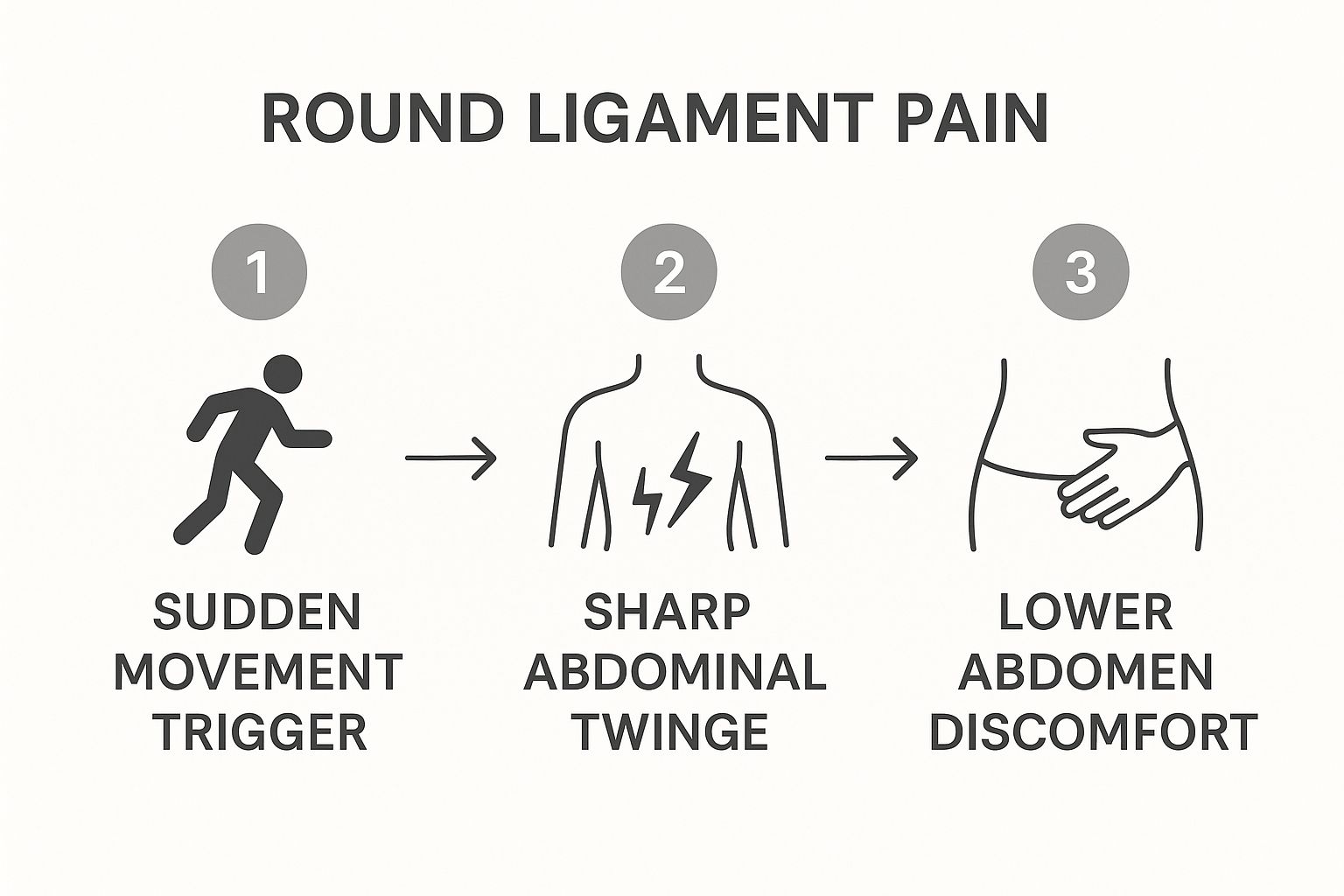
As you can see, it doesn't take much to set off that twinge. By adding these simple, regular stretches into your routine, you can help prevent that initial trigger from turning into such an intense, painful spasm in your ligaments.
Practical Tips For Easy Integration
Making this a habit is probably easier than you think. Try doing a few pelvic tilts before you even get out of bed in the morning—it’s a perfect way to wake up your core muscles gently. If you have a desk job, set an alarm on your phone to remind you to stand up for a few cat-cow stretches every hour. It's a great way to break up long periods of sitting.
Here are a couple more movements to work into your day:
- Side-Lying Leg Lifts: While lying on your side, slowly lift your top leg just a few inches and then gently lower it back down. This is a great way to strengthen the hip muscles that are working so hard to support your pelvis right now.
- Child’s Pose: From your hands and knees, spread your knees wide enough to make plenty of room for your belly. Then, fold forward and rest your forehead on the floor. This gives you a wonderfully gentle stretch for your lower back and hips.
Remember, the goal is always gentle release, not an intense, deep stretch. If you feel any sharp pain, stop right away. Your body is doing incredible work, and these movements are all about giving it support, not adding more stress.
For more ideas on how to keep your body feeling good throughout your pregnancy, exploring a variety of safe exercises and stretches can enhance your journey and help prepare you for labor.
Small Lifestyle Shifts for Big Relief
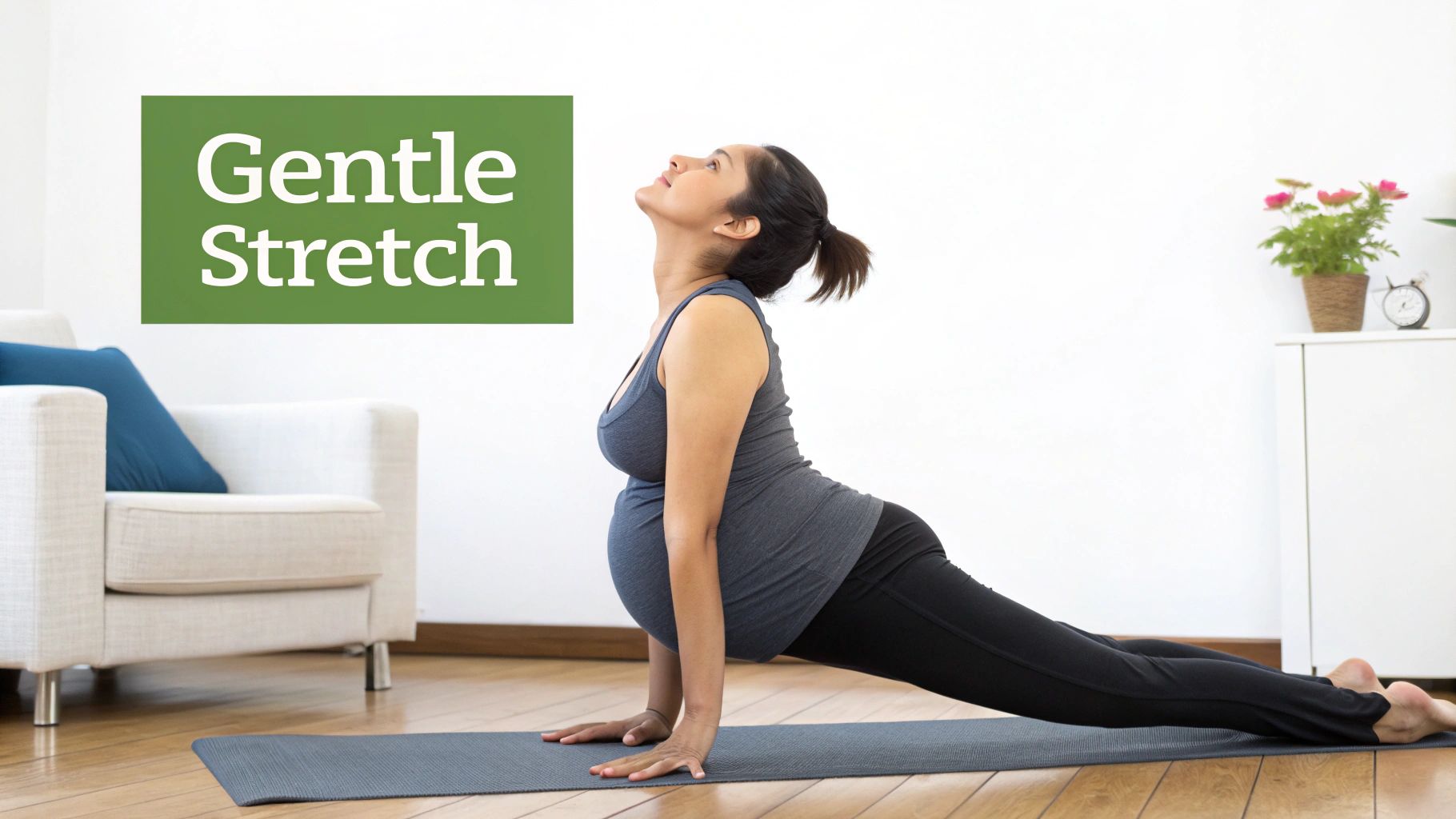
While specific stretches are incredible tools, some of the best relief for round ligament pain comes from making small, conscious shifts in your everyday movements. It's all about moving with more intention to avoid those sudden, sharp actions that make the ligaments spasm. Think of it as learning to anticipate what your body needs before it sends you a painful little reminder.
Something as simple as getting out of bed can be a huge trigger. Instead of sitting straight up from your back, which puts a ton of strain on your core, try rolling onto your side first. From there, use your arms to gently push yourself up to a sitting position. The same idea applies when you stand up from a chair—scoot to the edge and use your legs to push up, rather than pulling yourself forward with your abs.
Master Your Posture
How you carry yourself all day long—both sitting and standing—matters more than you might realize. When your lower back sways forward, creating a deep curve, it puts constant, low-grade tension on those round ligaments.
Try to be mindful of your alignment. Gently tuck your pelvis under, almost as if you're trying to point your pubic bone toward your belly button. This simple adjustment creates a more neutral spine and gives your growing uterus much better support.
And don't forget hydration! Like all the connective tissues in your body, your ligaments need plenty of water to stay pliable and healthy. Sipping water consistently throughout the day can make a surprising difference in how irritated they get.
Pro Tip: One of the most practical habits to build is bracing yourself for impact. Right before you cough, sneeze, or even have a big laugh, bend forward just a little at your hips. This tiny movement instantly puts slack in the ligaments, preventing that forceful, unexpected yank from the sudden tensing of your abs.
This bracing technique is a complete game-changer because you're working with your body's mechanics, not against them. You're essentially giving those ligaments a heads-up. It might feel a little strange at first, but these mindful adjustments add up to significant relief by creating a more stable and supported environment for your body.
Using Support Garments and Comfort Measures
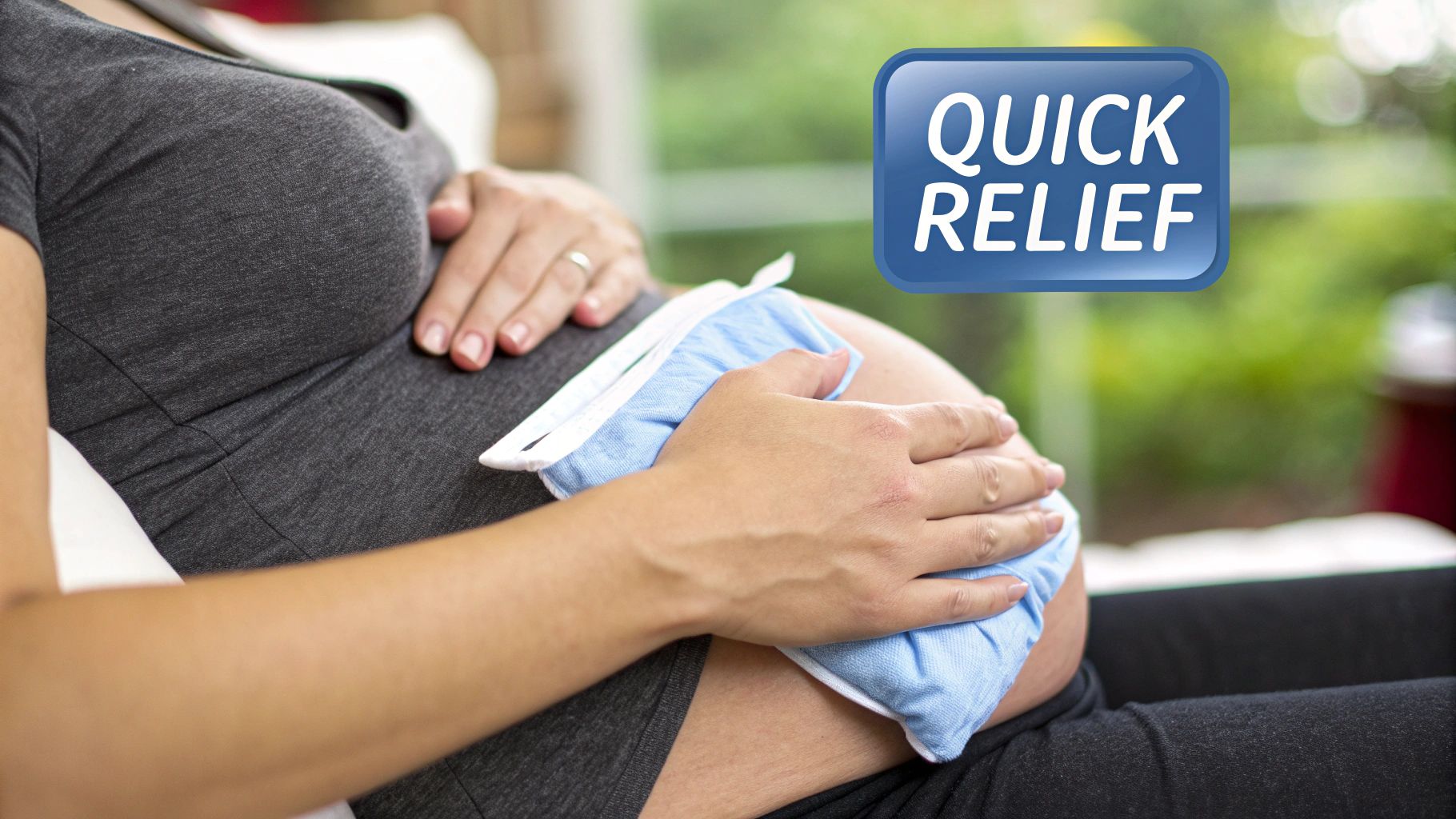
Sometimes, the simplest solutions offer the most relief. As your belly grows, those round ligaments are working overtime to support the increasing weight, and giving them a little external help can be a total game-changer. A good maternity support belt or belly band provides a gentle lift to your abdomen, easing that constant tension.
Think of it like a sports bra for your growing belly. That little bit of lift can dramatically reduce the sharp, pulling sensation, especially when you’re walking or standing for long periods. When you’re active, a support garment offers stability and can stop those painful spasms before they even start.
When you’re picking one out, make sure it has adjustable straps and is made from breathable material. You’re aiming for a supportive hug, not a restrictive squeeze.
Finding Soothing Comfort With Warmth
Beyond physical support, never underestimate the power of warmth to soothe tight, irritated ligaments. Applying gentle heat is a fantastic way to help relax the tense muscles in your groin and lower abdomen, taking the edge off that nagging ache.
A warm bath is often the perfect remedy. Not only does the water support the weight of your belly, but the warmth penetrates those sore, tired areas. No time for a full soak? A warm compress or a heating pad on its lowest setting can work wonders, too.
Just be sure to keep safety in mind:
- Always place a towel between the heating pad and your skin.
- Keep it on for just 10-15 minutes at a time.
- Avoid placing a heating pad directly on your belly—focus on your hips or lower back instead.
Combining a supportive belt during the day with a warm, relaxing bath at night is a powerful one-two punch against round ligament pain. This approach tackles both the mechanical strain on your ligaments and the muscular tension that follows.
This kind of external support works best when your body’s internal structures are also properly aligned. For many expecting moms, pairing these at-home comfort measures with specialized care is what brings the most complete relief. In fact, many women find that the benefits of pregnancy chiropractic include better pelvic balance, which can directly reduce the strain on your ligaments.
When to Call Your Doctor About Groin Pain
Those brief, sharp twinges from round ligament pain are a totally normal—if annoying—part of pregnancy. But it's so important to trust your gut. Not all groin pain is created equal, and knowing when to pick up the phone is key to keeping you and your baby safe.
The classic round ligament pang is a flash in the pan. It hits when you move suddenly and is gone in a few seconds. If what you're feeling is severe, constant, or comes in rhythmic waves like cramps, it's time to call your doctor or midwife. Those could be signals of something else that needs a closer look.
Distinguishing Normal From Concerning Symptoms
Pay close attention if the pain comes with any other red-flag symptoms. You should get in touch with your healthcare provider right away if your pain shows up alongside any of these:
- Fever or chills
- Any vaginal bleeding or spotting
- Serious difficulty walking
- Pain or a burning sensation when you urinate
- More than four contractions in an hour, even if they don't hurt
These symptoms aren't typical for round ligament discomfort. They warrant a professional check-up to rule out other issues, like a urinary tract infection or preterm labor.
Your peace of mind is what matters most. It is always, always better to call and get reassurance that everything is fine than to sit at home worrying about whether a symptom is serious.
In some rare cases, groin pain can point to other conditions. For instance, round ligament varicosity, which affects a tiny fraction—about 0.13%—of pregnant women, can cause a persistent aching pain or even a noticeable lump in the groin. This requires an ultrasound for a proper diagnosis and it’s important to distinguish from other potential problems. You can dig deeper into these findings through this medical library resource.
Ultimately, you know your body better than anyone. If something just feels off, or if the pain is intense and won't let up, don't hesitate. Make the call.
Common Questions About Round Ligament Pain
Even when you know round ligament pain is a normal part of pregnancy, it’s completely natural for questions to pop up. Understanding the why behind those sharp twinges can give you more confidence as you navigate this common symptom. Let's tackle some of the questions we hear most often from expecting mamas.
Can Round Ligament Pain Happen on Only One Side?
Absolutely. It’s not just possible—it’s actually very common to feel those zingers more intensely on just one side. For many women, this happens to be the right side.
This isn't a coincidence. As your uterus grows, it often tilts slightly to the right, which puts a little extra tension on that particular ligament. Of course, feeling it on the left, on both sides at once, or even having it switch sides is also completely normal. Every body and every pregnancy is unique.
How Early in Pregnancy Can This Pain Start?
While round ligament pain is famous for making its debut in the second trimester, it can definitely show up earlier. It’s not unusual for some women to start feeling those tell-tale pangs near the end of the first trimester, often around week 12 or 13.
This is right around the time your uterus begins to lift out of the pelvis, kicking off that stretching process. The exact timing varies from person to person, so don't be alarmed if you feel it sooner than you expected.
The bottom line is that your ligaments are adapting to make room for your growing baby. Whether it's a one-sided ache or an early arrival, these are typically normal variations of the same process.
Does a Maternity Belt Really Help With This Pain?
Yes, for many women, a good support belt or belly band can be a game-changer. Think of it this way: a well-designed maternity belt gently lifts the weight of your growing belly. This directly reduces the pulling sensation on your round ligaments.
This external support can significantly decrease how often you feel the pain and how intense it is, especially when you're on your feet, walking, or exercising.
What About Using Heat for Relief?
Many people want to know about safe, at-home ways to soothe the ache. Here’s what you need to know about heat therapy:
- Is a heating pad safe? Using a warm compress or a heating pad on a low setting is generally considered safe for short periods, about 10-15 minutes at a time. The most important thing is to avoid raising your core body temperature.
- How do I use it safely? Never place a heating pad directly on your baby bump. Instead, focus on the surrounding areas where you feel the pull—your hip, groin, or lower back. Always wrap the heating pad in a towel to create a barrier between the heat and your skin.
When in doubt, a warm bath is often a safer and equally effective option for all-over relaxation and relief.
At First Steps Chiropractic, we believe in addressing the root cause of discomfort to help you have a more comfortable pregnancy. Our gentle, neurologically-focused techniques, including the Webster Technique, can help improve pelvic balance and reduce ligamentous strain. Learn more about our approach to prenatal care.
